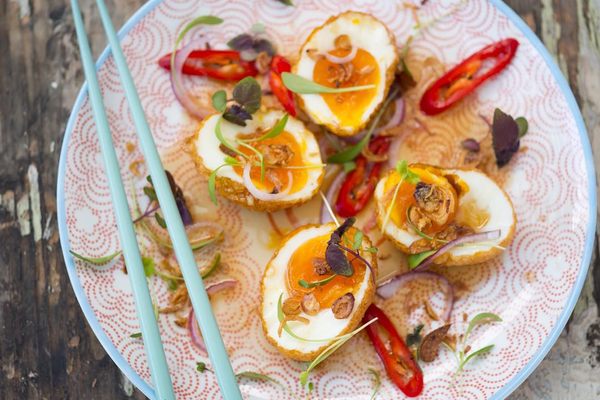Sweets
Luk Chup
Portuguese traders' love of marzipan paved the way for Thailand's vibrant mung bean candy.
In Thailand, vendors selling luk chup may appear to be peddling tchotchkes. Passersby are drawn to tables covered in glistening heaps of miniature oranges, watermelons, pigs, eggplants, cherries, and more. But to decide these replicas are too pretty to eat would be a waste. Beneath their exterior of vibrant, shiny gelatin, these treats house a filling of creamy, sweetened mung bean paste.
Portuguese traders are likely responsible for introducing Thais to the confection that became luk chup. They arrived in the region, then known as Siam, as early as 1511, drawn by international trade opportunities in the wealthy city of Ayutthaya. The Dutch, English, Spanish, and French all followed, but the Portuguese were among the first arrivals. With them came a taste for marzipan (massapão), a sugary almond paste that remains ubiquitous in much of Europe today. In the absence of almonds, European traders satisfied their cravings by subbing in peanuts or mung beans to re-create the soft, decadent sweet. Like Italy’s frutta martorana, which feature marzipan replicas of petite, ornate fruits, pieces of luk chup often took the form of produce. Southeast Asia’s wealth of natural dyes, such as pandan leaf extract and butterfly pea flower, gave the dainty creations an extra pop of vibrancy.
Today, Thai candy-makers fashion these stunning desserts by soaking and boiling mung beans in coconut milk. Once the pot’s contents become a creamy pulp, they gradually add palm sugar, stirring the mixture for hours at a time. After shaping the dough into anything from fruit and vegetables to seafood and animals, they glaze the creation in pigmented gelatin. Tasters are often surprised to discover that the finished candy tastes nothing like fruit, so if mung bean isn’t your thing, luk chup might be too pretty to eat, after all.
Where to Try It
-
Baan Luk Chup
Arun Ammarin Soi 37, Thonburi, Bangkok, 10600, ThailandThis shop has sold beautifully-made mung bean candies since the 1970s.
Written By
 rachelrummel
rachelrummel
Sources
- www.travelfish.org/eatandmeet_profile/thailand/bangkok_and_surrounds/bangkok/thonburi/1845
- www.bangkok.com/magazine/5-sweets.htm
- www.rantandroam.com/colorful-luk-chup-candies/
- www.saveur.com/villabate-alba-sicilian-italian-marzipan
- www.britannica.com/place/Thailand/Mon-Khmer-civilizations#ref509771
- www.travelandleisure.com/slideshows/worlds-strangest-candy#1
The Atlas Obscura Podcast is Back!





















